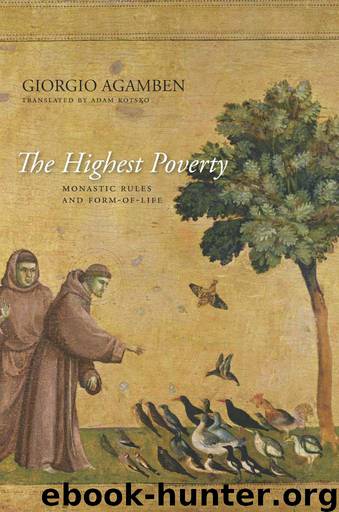The Highest Poverty: Monastic Rules and Form-of-Life by Agamben Giorgio

Author:Agamben, Giorgio [Agamben, Giorgio]
Language: eng
Format: epub
Publisher: Stanford University Press
Published: 2013-04-17T04:00:00+00:00
§ 3 The Rule as a Liturgical Text
3.1. Lectio has been an essential part of the Christian liturgy since its origins. Today it is generally acknowledged that it derives from the practice of the (most likely sung) reading of the Torah (qeri’at Torah) in the synagogue. Two of the earliest testimonies to this reading, whose origin the tradition traces back to Moses (Deut. 31:10–11: “Every seventh year, in the scheduled year of remission, during the festival of booths, when all Israel comes to appear before the LORD your God at the place that he will choose, you shall read this law before all Israel in their hearing”), are in the New Testament. The first (Acts 13:15) shows Paul attending the reading of the law (anagnosis tou nomou) with his companions in the synagogue of Antioch, where he is later invited to comment on the passage read (“After the reading of the law and the prophets, the officials of the synagogue sent them a message, saying, ‘Brothers, if you have any word of exhortation for the people, give it’”). In the second (Luke 4:16–21), it is Jesus himself who is to perform the reading in the synagogue of Nazareth and comment on it:
He went to the synagogue on the Sabbath day, as was his custom. He stood up to read, and the scroll of the prophet Isaiah was given to him. He unrolled the scroll and found the place where it was written: “The Spirit of the Lord is upon me, because he has anointed me to bring good news to the poor. He has sent me to proclaim release to the captives and recovery of sight to the blind, to let the oppressed go free, to proclaim the year of the Lord’s favor.” And he rolled up the scroll, gave it back to the attendant, and sat down. The eyes of all in the synagogue were fixed on him. Then he began to say to them, “Today this scripture has been fulfilled in your hearing.”
These two testimonies show that the text of the Torah was read in the synagogue already at the time of Jesus, perhaps already divided (as we know from later sources) into parachot (pericopes); that beyond the Pentateuch, passages from the prophets (called haftarot) were also read; and that the reading was followed by a homiletical commentary (derashah), of which Paul and Jesus offer us an example.
The reading of the Torah gradually assumes the form of a lectio continua, which in Palestine was articulated according to a triennial cycle that began the first or second Sabbath of the month of Nisan. In Babylon, the length was one year, with a beginning after the Feast of Tabernacles (Werner, p. 89). The reading of the prophets was not continual, however, but consisted each time of an isolated passage chosen to correspond to the passage from the Torah that was read that day.
The Church followed the example of the synagogue by instituting readings of the Old Testament (at first most
Download
This site does not store any files on its server. We only index and link to content provided by other sites. Please contact the content providers to delete copyright contents if any and email us, we'll remove relevant links or contents immediately.
The Secret History by Donna Tartt(18865)
The Social Justice Warrior Handbook by Lisa De Pasquale(12143)
Thirteen Reasons Why by Jay Asher(8802)
This Is How You Lose Her by Junot Diaz(6804)
Weapons of Math Destruction by Cathy O'Neil(6152)
Zero to One by Peter Thiel(5694)
Beartown by Fredrik Backman(5610)
The Myth of the Strong Leader by Archie Brown(5429)
The Fire Next Time by James Baldwin(5253)
How Democracies Die by Steven Levitsky & Daniel Ziblatt(5134)
Promise Me, Dad by Joe Biden(5090)
Stone's Rules by Roger Stone(5029)
A Higher Loyalty: Truth, Lies, and Leadership by James Comey(4851)
100 Deadly Skills by Clint Emerson(4845)
Rise and Kill First by Ronen Bergman(4706)
Secrecy World by Jake Bernstein(4653)
The David Icke Guide to the Global Conspiracy (and how to end it) by David Icke(4629)
The Farm by Tom Rob Smith(4443)
The Doomsday Machine by Daniel Ellsberg(4421)
